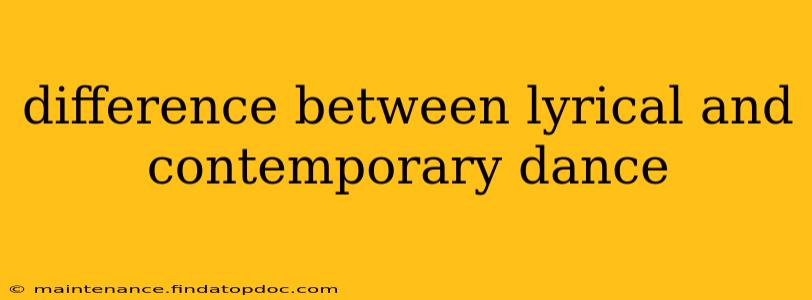Lyrical vs. Contemporary Dance: Unveiling the Differences
Dance, a universal language of movement, encompasses a vast spectrum of styles. Two prominent forms, lyrical and contemporary dance, often share similarities but possess distinct characteristics. Understanding these differences can enhance appreciation for the artistry and technique involved in each.
This article delves into the nuances of lyrical and contemporary dance, clarifying their unique features and addressing common questions.
What is Lyrical Dance?
Lyrical dance is a highly expressive style that blends ballet technique with the emotional freedom of modern dance. It's characterized by its fluid, graceful movements that aim to tell a story or convey a specific emotion through choreography. Think flowing arm movements, controlled leaps, and expressive facial features, all synchronized with music – often emotionally charged ballads or musical theater pieces. While technically demanding, lyrical dance prioritizes the conveyance of feeling over strict adherence to rigid forms.
What is Contemporary Dance?
Contemporary dance is a more eclectic and diverse style that draws inspiration from various dance forms, including ballet, modern, jazz, and even elements of improvisation. It often incorporates floor work, contractions and releases, and less emphasis on pointed toes and rigid turnout found in classical ballet. Contemporary dance is less focused on storytelling and more concerned with exploring movement vocabulary and the dancer's physicality and emotional expression. Its choreography can be highly abstract and experimental.
What are the Key Differences Between Lyrical and Contemporary Dance?
The core differences between lyrical and contemporary dance lie in their technique, focus, and expression:
-
Technique: Lyrical dance heavily relies on ballet technique, emphasizing precise lines, pointed toes, and graceful movements. Contemporary dance draws from a broader range of techniques, often incorporating floor work, release, and contractions. It allows for greater freedom and less adherence to traditional ballet forms.
-
Musicality: Lyrical dance is deeply rooted in musicality. The choreography is meticulously crafted to follow the nuances of the music, emphasizing emotional storytelling through movement. Contemporary dance, while still using music, can be more independent of the music's specific rhythm and tempo, allowing for a greater exploration of movement itself.
-
Expression: Lyrical dance often focuses on conveying a specific narrative or emotion through the choreography. The dancer's expression is crucial to conveying the story or feeling. Contemporary dance is more concerned with exploring movement's expressive potential, allowing for a wider range of interpretations. It may focus on conveying an idea or concept rather than a specific story.
-
Choreography: Lyrical choreography tends to be more fluid and flowing, using ballet-based vocabulary to portray emotional depth. Contemporary choreography can be more angular, abstract, and experimental, showcasing a greater variety of movement styles and techniques.
What are the similarities between Lyrical and Contemporary dance?
Despite their differences, both lyrical and contemporary dance share some common ground:
-
Emphasis on Emotion: Both styles place strong emphasis on conveying emotion and storytelling through movement. The dancer's emotional investment plays a vital role in both forms.
-
Expressiveness: Both dance forms demand strong expressive capabilities from the dancer, including facial expressions, body language, and controlled movement to convey emotions and ideas effectively.
-
Technical Skill: While their techniques differ, both lyrical and contemporary dance demand high levels of technical skill, strength, flexibility, and control from the dancers.
Is lyrical dance harder than contemporary?
This is subjective and depends on the dancer's strengths and weaknesses. Lyrical dance often requires strong ballet foundations, making it potentially more challenging for those without prior ballet training. Contemporary dance, with its more varied vocabulary and often improvisational elements, can be challenging in a different way. Ultimately, the “harder” style depends on individual aptitudes and preferences.
Can you do both lyrical and contemporary dance?
Absolutely! Many dancers successfully train and perform in both lyrical and contemporary styles. The foundational skills developed in one can often be transferable to the other, enriching the dancer's overall abilities and expressive range.
In conclusion, while both lyrical and contemporary dance share a common thread of expressive movement, they differ significantly in their techniques, focus, and approaches to choreography and storytelling. Understanding these distinctions allows for a greater appreciation of the artistry and skill involved in each form.
